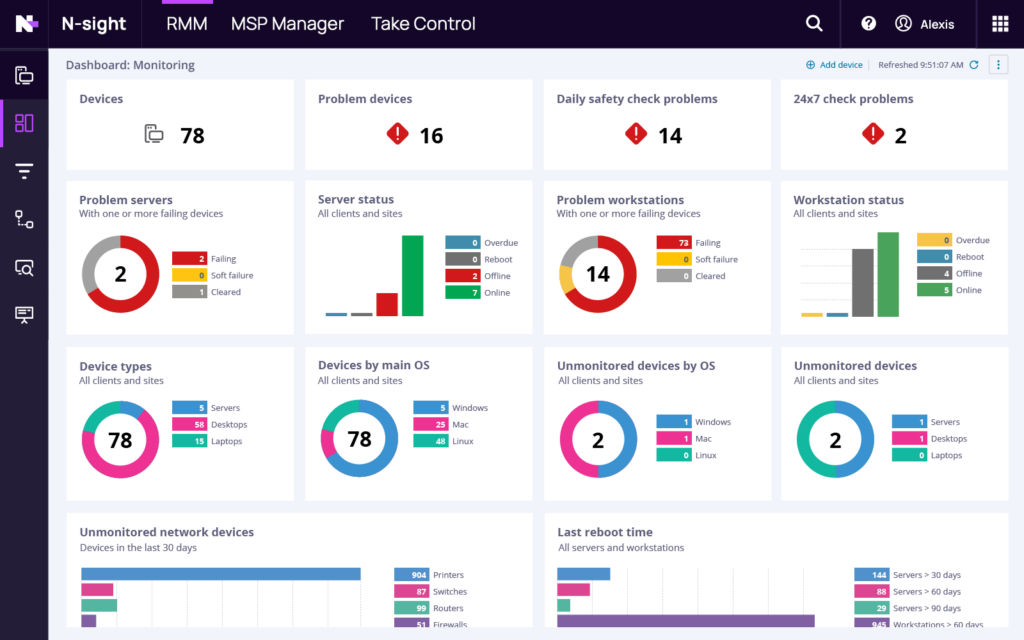From servers to smartphones, schools and businesses depend on scores of devices. Managing this technology landscape can become complex quickly without the right tools. This is where RMM and MDM software come in handy!
But what’s the difference between RMM and MDM? When should you use one over the other? This article explains both technologies and provides tips on selecting the best solution for your environment.
Table of Contents
What is RMM Software?

The abbreviation “RMM” stands for remote monitoring and management. The name suggests that RMM tools allow for the central supervision of devices from afar.
To be sure, you can see RMM as a command center that manages servers, desktop computers, on-premise infrastructure, networking equipment etc. RMM software enables:
- 👁️Real-time monitoring: Get continuous health metrics on memory, disk space, CPU usage across devices.
- 📋 Asset tracking: Maintain detailed inventory reporting including hardware and software.
- 🔔 Proactive alerts: Get warned about issues like low disk space before outages happen.
- 🛠️ Remote maintenance: Perform patches, updates, script execution without visiting devices.
For example, the RMM dashboard may alert if a classroom computer lacks a critical Windows update. Your IT team can then quickly push out the patch remotely without needing to go to the machine.
So in short, RMM focuses on tracking and securing large static devices like servers and desktops.
What is MDM Software?
MDM expands to “mobile device management.” MDM solutions help organizations control and secure smartphones, tablets, laptops, mobile endpoints and newer device types like wearables.
Typical MDM capabilities include:
- 📱 BYOD onboarding: Add personal phones & tablets issued to employees into management.
- 🔐 Config profiles: Apply security rules like passcode requirements remotely.
- 📲 Over-the-air commands: Push apps, settings, documents instantly to devices.
- 🔐 Selective wipe: Remotely delete only company data leaving personal files intact.
For example, your IT department can quickly deploy a new classroom app to all student iPads using the MDM. If a device is lost, they can remotely wipe school-related data while preserving personal content.
So in short, MDM is designed explicitly for managing mobile, portable endpoints.
Key Difference: Broad Infrastructure vs Mobile Devices
The core difference between RMM and MDM comes down to the device types they handle:
- RMM software focuses on large static hardware like on-premise servers, desktops, networking equipment.
- MDM solutions cater primarily to mobile devices like smartphones, tablets, laptops.
Here is a chart summarizing the core device targets:
| RMM Target Devices | MDM Target Devices |
| Servers | Smartphones |
| Desktop computers | Tablets |
| Networking hardware | Laptops |
| On-premise infrastructure | Wearables |
RMM vs MDM – Comparing Key Features
While RMM and MDM share some common functionality like remote access, monitoring and administration features, they have some unique capabilities:
RMM Key Features
- Granular server performance monitoring
- Automated patch deployment
- Advanced scripting and task automation
- Customizable role-based access control
MDM Key Features
- BYOD and personal device enrollment
- Configure email, WiFi, VPN profiles
- App blacklisting/whitelisting
- Lost device locate, lock and wipe
Which Should You Choose for Your Organization?
So which solution should you implement for optimal device management? Here are some guidelines:
Pick RMM software if:
- You have an extensive on-premise IT infrastructure with many servers, networking hardware.
- Your priority is keeping critical systems up and running smoothly.
- You need automated patching, upgrades and robust monitoring.
Pick MDM software if:
- Your workforce relies heavily on smartphones, tablets, laptops.
- You want employees to securely use personal devices for work under BYOD policy.
- Protecting proprietary data on mobile devices is important.
For many large schools and enterprises, using both RMM and MDM together provides the best of both worlds. RMM handles backend infrastructure uptime while MDM secures access from anywhere on mobile devices.
Combining them offers full visibility into the complete technology stack from server racks to tablets and everything in between!
Conclusion
RMM and MDM solve overlapping but distinct device management challenges that organizations face today. RMM streamlines monitoring and administration for on-premise infrastructure. MDM enables securing a dispersed mobile workforce.
Using these solutions together provides centralized visibility and control across the entire technology environment. With robust automation and security spanning servers to smartphones, your IT team can achieve peak efficiency.
Empower your technology stack from edge to core with the combined power of RMM and MDM solutions! Reach out if you need any help assessing your management requirements.
FAQs
Most RMM platforms focus on servers, desktops and on-premise hardware. For robust mobile device management, a dedicated MDM solution is recommended.
No, MDM is designed explicitly for managing mobile endpoints. For servers, networks and other infrastructure, a full-featured RMM tool is more appropriate.
Leading unified endpoint management platforms provide tight RMM and MDM integration out-of-the-box. This makes managing both infrastructure and mobile transparent.
